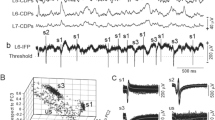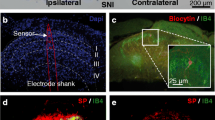Summary
Single unit potentials can be recorded directly with wire electrodes during an operation in man. Since averaging is not necessary this recording method is a fast neuromonitoring tool. Using 2 pairs of platinum electrodes it was possible to record extracellular single unit potentials at 2 sites in nerve root filaments in the spinal canal and to determine conduction velocities. Afferent and efferent single unit potentials could be distinguished from each other by a reversed conduction time and a reversed potential change making a differentiation between dorsal and ventral root parts possible. An activity increase due to touching the skin could be recorded. Therefore dermatomes of nerve root filaments and root filaments of dermatomes can be identified during the operation.
Similar content being viewed by others
References
Carlsson CA, Sundin T (1967) Reconstruction of efferent pathways to the urinary bladder in a paraplegic child. Rev Surg 24: 73–76
Carlsson CA, Sundin T (1980) Reconstruction of afferent and efferent nervous pathways to the urinary bladder in two paraplegic patients. Spine 5: 37–41
Coggeshall RE, Applebaum ML, Frasen M, Stubbs TB, Sykes MT (1975) Unmyelinated axons in human ventral roots, a possible explanation for the failure of dorsal rhizotomy to relieve pain. Brain 98: 157–166
Coggeshall RE, Haruhide I (1977) Sensory fibres in ventral roots L7 and S1 in the cat. J Physiol 267: 215–235
Coggeshall RE (1980) Law of separation of function of the spinal roots. Physiological Reviews 60: 716–755
Frazier CH, Mills CK (1912) Intradural root anastomosis for the relief of paralysis of the bladder. Jama 59: 2202–2206
Goldstein SS, Rall W (1974) Changes of the action potential shape and velocity for changing core conductor geometry. Biophys J 14: 731–757
Howe JF, Loeser JD, Calven WH (1977) Mechanosensitivity of dorsal root ganglia and chronically injured axons: A physiological basis for the radicular pain of nerve root compression. Pain 3: 25–41
Light AR, Perl ER (1984) Peripheral sensory systems. In: Dyck PI, Thomas PK, Lambert EH, Bunge RP (eds) Peripheral neuopathy, volume 1. Saunders Company, pp 210–239
Loeb GE (1976) Decreased conduction velocity in the proximal projections of myelinated dorsal root ganglion cells in the cat. Brain Res 103: 381–385
Paintal AS (1953) The conduction velocities of respiratory and cardiovascular afferent fibres in the vagus nerve. J Physiol 121: 341–359
Paintal AS (1965) Effect of temperature on conduction in single vagal and saphenous myelinated nerve fibres of the cat. J Physiol 180: 20–49
Patil A (1981) Intercostal nerves to spinal nerve roots anastomosis (spinal cord bypass) and Harrington rod fusion in traumatic paraplegia—Technical note. Acta Neurochir (Wien) 57: 299–303
Ploncard Ph (1982) A new approach to the intercosto-brachial anastomosis in the treatment of brachial plexus paralysis due to root avulsions. Late results. Acta Neurochir (Wien) 61: 281–290
Rasminsky M (1978) Ectopic generation of impulses and crosstalk in spinal nerve roots of “dystrophic” mice. Ann Neurol 3: 351–357
Schalow G (1985) The problem of cauda equina nerve root identification. Zbl Neurochirurgie 46: 322–330
Sperry RW (1945) The problem of central nervous reorganisation after nerve regeneration and muscle transposition. Quart Rev Biol 20: 311–369
Sperry RW (1947) Effect of crossing nerves to antagonistic limb muscles in the monkey. Arch Neurol Psychiat (Chicago) 58:452–473
Vallbo ÅB (1976) Prediction of propagation block on the basis of impulse shape in single unit recordings from human nerves. Acta Physiol Scand 97: 66–74
Vallbo ÅB, Hagbarth KE, Torebjörk HE, Wallin BG (1979) Somatosensory, propioceptiv and sympathetic activity in human peripheral nerves. Physiol Rev 59: 919–957
Voorhoeve PE, Zwaagstra B (1984) Central effects by ventral root nociceptive afferents. In: Creutzfeldt O, Schmidt RF, Willis WD (eds) Sensory-motor integration in the nervus system. Springer, Berlin Heidelberg New York Tokyo, pp 116–125
Zottermann Y (1939) Touch, pain and tickling: An electrophysiological investigation on cutaneous sensory nerves. J Physiol 95: 1–28
Author information
Authors and Affiliations
Rights and permissions
About this article
Cite this article
Schalow, G., Lang, G. Recording of single unit potentials in human spinal nerve roots: A new diagnostic tool. Acta neurochir 86, 25–29 (1987). https://doi.org/10.1007/BF01419500
Issue Date:
DOI: https://doi.org/10.1007/BF01419500




